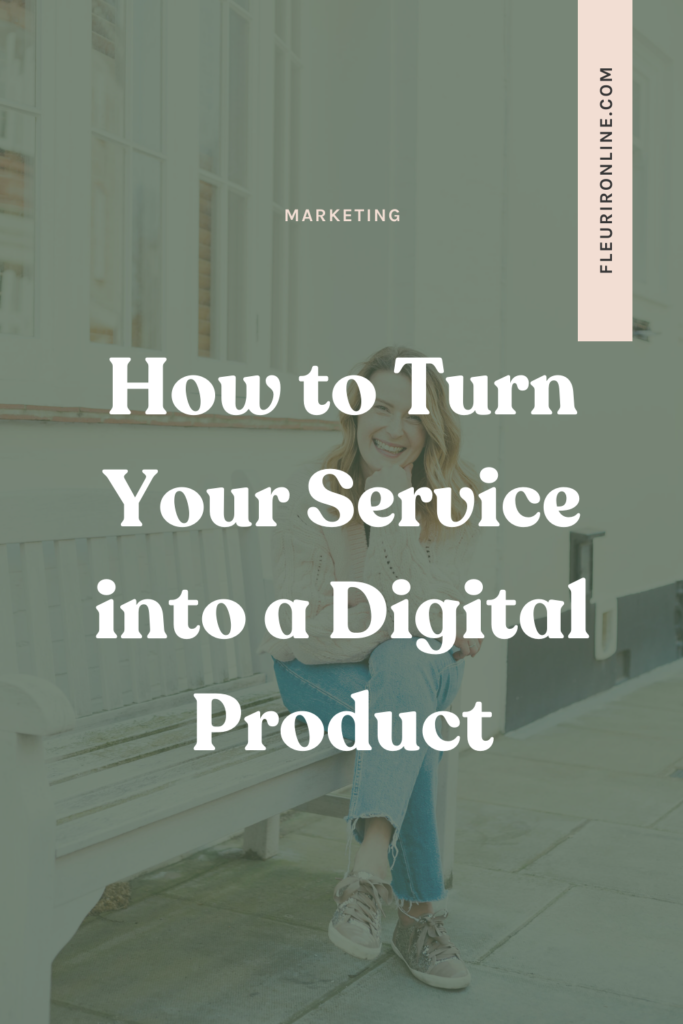Hey and welcome back to another episode of the Brand, Market, Flourish podcast where I’m talking about how to turn your service into a digital product.
If you’ve been thinking about adding digital products to your business or you are looking to explore ways in which you can scale your service-based business, then keep listening because this episode is for you.
I want to start by saying that I truly believe there is a time and a place in your business journey for digital products. If you’re listening to this and you’re a service provider who isn’t yet booking clients consistently then I’d strongly recommend that you keep working with clients 1:1 until you are at a point in your business where you have consistent clients and consistent income.
It’s often thought that selling higher ticket offers is harder and more work than selling lower ticket offers but that really isn’t the case. The amount of work that you put into either of these two things is the same. The difference is that you only need to book one high ticket client instead of trying to sell let’s say 50 of your lower ticket product.
However, if you are at a point in your business where you are booking clients consistently and you can feel that you are approaching or are already at maximum capacity with 1:1 clients, then this is your time.
Before we start, I want to let you know that at the time this episode goes live I’m currently accepting applications for the Expand Your Brand Mastermind. This mastermind has been created to support done-for-you service providers who are either at capacity with 1:1 client work, consistently booking 1:1 clients or feeling overwhelmed and burnt out by done-for-you offerings. Over six months, we will work together to package up your expertise into digital products so that you can expand your impact and your income without needing to find more hours in the day.
This mastermind is also for you if you already have a digital product shop but you’re not seeing the traction you’d hoped for.
I created my digital product shop two years ago this month and I’ve never looked back. I’ve since helped many service providers create and launch their digital products on a 1:1 basis and now I plan on doing the same with the Expand Your Brand Mastermind.
To find out more about Expand Your Brand, visit fleurironline.com/mastermind or check out the link in the show notes. We start in September but there are some early bird bonuses for you action takers out there, so don’t hang around too long!
Let’s get started with the episode, shall we?!

Listen to this Episode
Listen to this episode and subscribe using your favourite podcast app!
Apple Podcasts | Spotify
Two ways to scale your business as a service provider
It’s likely that there will come a time in your business when you’ll want to scale. This won’t always be the case. Some business owners are happy to maintain a consistent pace in their business. However, for those of you who are nearing capacity with your done-for-you offers, you might be thinking about how you can expand your brand without having to find more hours in the day.
There are two ways in which you can scale your service-based business. The first is via an agency model. This means that you hire contractors or in-house employees to work in your business so that you can take on more clients. The agency model isn’t for everyone however which leads me onto the second way to scale and that is through digital products.
Digital products are an amazing addition to your service-based business for many reasons. Let’s take a look at some of those reasons.
Why digital products are a great addition to your service-based business
1. Expand Your Impact
The first is that it allows you to expand your impact. Let’s face it, you only have so much time that you can and want to work. This means that the amount of clients you can take on is limited. You can’t work with everyone. But also, there will be people in your audience who aren’t quite ready to work with you on a 1 to 1 basis just yet. It’s likely that these people will be newer to business and are unable to invest but they still need your help. By packaging up your expertise into a digital product, you are able to help them for where they are at right now.
2. Expand Your Income
The second is that it allows you to expand your income. Once you have reached capacity with done-for-you client work, you also reach a ceiling limit in terms of your income. Yes, you can increase your pricing but you can only do that so much before you run the risk of being priced out of the market. Digital products have no limit in terms of the amount of money you can make. The initial investment is in the time it takes to create the product and then once it’s done, it’s a case of marketing it.
Also, how many times have you had a discovery call with someone and then they turn around and say that they can’t afford the investment? How many times have you connected with someone on Instagram who would love to work with you, only to learn that they are very new to business? I’m guessing a lot.
Wouldn’t it be great if instead of simply parting ways with that person, you could direct them to a product that would be a better fit for where they are at right now? A product that helps them and prepares them for when they are ready to work with you 1:1.
3. Creates more freedom
The third is that it can free up more time in your business. By building digital products into your business, you can have more freedom over your time. Once you have built up the digital product side of your business to a point where it is bringing in a regular source of income, you can be more flexible with your time without feeling like you need to be chained to your desk 9-5, or 5 days a week. Because let’s face it, we didn’t build our own businesses to work 40-hours a week. We built our businesses so that we can have more freedom. Digital products allow you that freedom.
4. You can be selective with who you work with 1:1
The fourth is that you can choose to work with absolute dream clients. We’ve all had nightmare clients. Clients that don’t respect our time. Clients that we just haven’t clicked with. Clients who expect us to go beyond the scope of the project. We’ve all been there. By adding a digital product revenue stream into your business, you’re not relying on 1:1 work as your only source of income. This means you can be pickier with who you work with. This means that you can work with absolute dream clients and say no to the ones that don’t feel like a good fit because you know that you don’t necessarily need the money.
As you can see, there are so many benefits to creating digital products in your business and even if you do go down the agency route where you hire more team members so that you can take on more clients, there’s nothing stopping you from adding digital products to your business as well.
How to turn your service into a digital product
Now we’ve talked about the benefits of digital products, let’s dive into how you can turn your service into a digital product.
1. Brainstorm some digital product ideas
I know it seems obvious but the first thing to do is to brainstorm ideas for your digital product.
More often than not your digital product is usually the first step or the first few steps in your customer journey. With this in mind, have a think about what your ideal clients might need before working with you?
You can ask yourself these questions:
- What do you help your clients with on a 1:1 basis?
- What are you often asked to help people with but you don’t have the capacity to do so?
- Do you want to mentor others in your industry with your knowledge of doing what you do?
- What steps come before working with you 1:1?
- What do new business owners need when they are first starting out but have little budget?
By answering these questions, I can guarantee that some ideas will come to mind. And to help you even further with those ideas, here are some to get you started.
If you’re a branding and website designer then it’s likely that your ideal clients for custom design work will be a couple of years into their business and not in the early stages. Therefore, think about what you can do to support those who aren’t quite ready to invest in custom design just yet. They still need a brand identity but they might just have to do it themselves. Therefore, you could create brand identity templates, website templates, a DIY your brand course, a brand strategy workbook. There are many options to choose from and all of these options will support businesses who want to invest in their brand identity and website but aren’t ready for a larger investment just yet.
If you’re a social media manager who works with clients managing their social media accounts, you’ll likely have a lot of knowledge around social media, what works, what doesn’t and what people need when they are first getting started etc… You could create social media templates, a course around a particular social media platform, caption templates. Again, there’s a lot of things that you can create.
If you’re a copywriter and you help business owners with their brand messaging and website copy, you can create templates or a course to help them with brand messaging so that they can do it themselves when they are starting out. You could provide prompt templates for website copy. You could even go one step further and collaborate with website designers who sell website templates and create some form of partnership there too.
As you can see, there are many different options when it comes to creating digital products in your business. It’s about thinking what is the step or steps before a client works with you 1:1 and then creating a product to help your audience with that.
2. Validate your idea with market research
Once you have come up with some ideas, it’s time to validate your idea with market research. Market research is essential when it comes to creating something new because you need to know if your audience is interested in the new product you’re creating. If you don’t do any market research around your product, then you may find that it’s not what they need and they in fact want or need something different. And there’s nothing worse than spending all that time creating your product only for it to fall completely flat when you launch.
There are many ways that you can do market research. A popular way is to use Instagram stories. Using the polls, quiz and scale features on stories gives your audience an easy way to interact with your survey meaning you get quicker responses and you get more of them. You can also create a survey using something like Google Forms or Typeform and send it to your email list or share it in your Instagram bio. Another way to do market research is via Facebook groups.
To then expand upon your market research even further, it’s worth doing some market research calls with those who have taken part in your surveys so that you can expand upon their responses in more detail. You’ll be surprised how many people are willing to do this. I like to offer some support in exchange for their time as a thank you too.
3. Set-up a waiting list
Once you’ve validated your idea through market research, it’s worth setting up a waitlist. The sooner you can begin to build a waitlist of people who are interested in your product, the better.
Your waitlist doesn’t need to be anything fancy. What you’ll need is a simple landing page with a bit of information on your product and then a form that’s connected to your email marketing platform. You’ll then want at least one automated email thanking them for joining the waitlist.
The key with creating a waitlist is to not set it and forget it. You need to keep those on the waitlist warm so create a plan to check in with them from time to time to keep them updated.
You can also share behind the scenes with your waitlist so that they can see how it’s coming along and share in your excitement.
4. Build and grow your audience
Launching a digital product without having an audience primed and ready to buy is a recipe for disaster. So often I’ll see business owners introduce a digital product too early in their business and then it won’t do well because they haven’t got the audience there yet.
You want to spend some time, I recommend around 8-12 weeks, warming up your audience. The marketing strategies you use to do this are entirely up to you and all depend on the amount of time, team members and where you feel comfortable marketing yourself.
When you’re creating the marketing plan to support your launch, be sure that it’s relevant to the product you’re creating. The easiest way to do this is to map out exactly what your digital product is going to look like. If it’s a template shop, ask yourself who it’s for and what templates are going to be included. If it’s a course, create an outline of the course including the modules and lessons that will be inside. You’ll also want to create an ideal client profile specifically for your product that details their goals, their pain points, their hesitations and their motivational triggers as well as basic demographic information such as gender if applicable, age, location etc…
5. Pre-sell your product
The best way to ensure that you don’t spend a lot of time creating your product only for it to fall flat is to pre-sell it. This will look different depending on what you’re creating. For example, if you’re creating website templates, you could share the mock-ups with your waitlist and your audience before you build them out. If you’re creating a course, you’d pre-sell spots on the course and then drip feed the content.
Pre-selling is a great way to generate income and interest in your product so you’re essentially being paid to create it.
6. Create your digital product
Provided you’ve managed to pre-sell your product and it’s worth your while, it’s now time to create it. Now, this is going to look different depending on what your digital product is. If it’s a course, then you’ll need to write out your lessons, create your slides, record your videos etc… You’ll also need to choose a platform to host your course as well. If you’re selling templates then you’ll need to build out these templates ready to send to those who pre-bought.
7. Listen to feedback and improve your digital product
Another great benefit of pre-selling or launching as a beta round first is that you can use this to test and improve your product.
When pre-selling your product, make your audience aware that they are getting a discounted price in exchange for their feedback and testimonials. They will of course receive updates to the product as it is further developed so they won’t only be getting the first version.
Send out feedback surveys and take on board what they are saying. You’ll want to use this information to make improvements to your product ready for the official launch.
8. Launch your digital product
So, you’ve pre-sold your product, you’ve created it and you’ve made amendments to it based on the feedback you received. Your product is now ready to be officially launched and put out there into the world.
By this point, you’ll have spent time warming up your audience so that they are primed and ready to buy. You’ll have a product that you know people need. You’ll have testimonials so the social proof will be there.
There is so much I can say about launching your digital product but I’ll save that for another episode because I think it deserves one of its very own.
9. Carry on marketing
It’s important that you don’t stop marketing as soon as you’ve launched. This is especially true with digital products that are always available such as templates. You’ll need to be continually marketing your shop in order to see the growth you desire. There are many ways in which you can do this but a really great way is by turning your customers into your biggest fans. Create an affiliate program and share with them a percentage for every sale they send your way. Again, I’ll do another episode around creating an affiliate program for your digital product in the future.
Your digital product isn’t going to deflect away from the value of your 1:1 offerings.
Before I wrap up this episode I want to talk about a common worry I hear from people who want to create digital products. That is that they fear that their product will distract customers from their higher-level offerings meaning that they won’t get as many 1:1 clients. I can assure you that this most definitely is not the case. In fact, it can actually work to increase interest in 1:1 client spots as those who purchased from you before, are far more likely to come back to you again. It’s all about the customer journey. It’s not about either-or, it’s about meeting your audience where they are at and giving them what they need and that’s what you’ll be doing with your digital product.
Apply for the Expand Your Brand Mastermind
If you’re a done-for-you service provider and you’re ready to expand your impact and your income by packaging up your expertise into digital products, then I’d love to invite you to apply for the Expand Your Brand Mastermind. This mastermind runs for six months from September and has been designed to support service-based business owners in scaling their business through digital products.
I’m bringing together a group of women who are all on the same path to the same end goal. To create more freedom in their business. To expand their impact in their industry. To work less and make more.
If this sounds like you visit fleurironline.com/mastermind or click on the link in the show notes.



